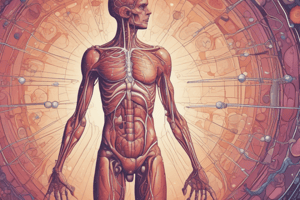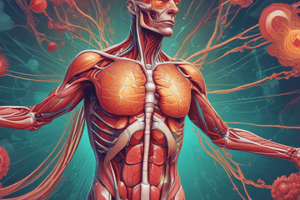Podcast
Questions and Answers
What is the primary function of the thymus?
What is the primary function of the thymus?
- To house 'good bacteria' in the gut
- To mature a specific type of white blood cell (correct)
- To produce red blood cells
- To trap pathogens from the food we eat
What is the main function of tonsils and adenoid?
What is the main function of tonsils and adenoid?
- To produce white blood cells
- To trap pathogens from the food we eat and air we breathe (correct)
- To monitor and destroy bacteria in the intestines
- To break down food into molecules
What is the role of Peyer's patches in the digestive system?
What is the role of Peyer's patches in the digestive system?
- To absorb nutrients from food
- To eliminate waste products
- To produce digestive enzymes
- To monitor and destroy bacteria in the intestines (correct)
What is the function of the appendix in the digestive system?
What is the function of the appendix in the digestive system?
What is the primary function of the digestive system?
What is the primary function of the digestive system?
What is the name of the long continuous tube that extends from the mouth to the anus?
What is the name of the long continuous tube that extends from the mouth to the anus?
What are the accessory structures located in the mouth?
What are the accessory structures located in the mouth?
What are the major accessory organs that have a role in digestion?
What are the major accessory organs that have a role in digestion?
What is the minimum time the sponge must be left in the vagina after the last act of intercourse?
What is the minimum time the sponge must be left in the vagina after the last act of intercourse?
What is the typical use failure rate for women who have had a baby using a sponge?
What is the typical use failure rate for women who have had a baby using a sponge?
What type of condoms do not provide protection against STDs, including HIV?
What type of condoms do not provide protection against STDs, including HIV?
What is the recommended usage of condoms?
What is the recommended usage of condoms?
What type of lubricants should not be used with latex condoms?
What type of lubricants should not be used with latex condoms?
What is the typical use failure rate for female condoms?
What is the typical use failure rate for female condoms?
How long before intercourse can a female condom be inserted?
How long before intercourse can a female condom be inserted?
How long must spermicides be left in place after intercourse?
How long must spermicides be left in place after intercourse?
What is the primary function of the kidneys in the body?
What is the primary function of the kidneys in the body?
What is the waste product produced when foods containing protein are broken down in the body?
What is the waste product produced when foods containing protein are broken down in the body?
What is the role of nephrons in the kidneys?
What is the role of nephrons in the kidneys?
What is the function of the renal tubules in the kidneys?
What is the function of the renal tubules in the kidneys?
What is the function of the ureters in the urinary system?
What is the function of the ureters in the urinary system?
How often do small amounts of urine empty into the bladder from the ureters?
How often do small amounts of urine empty into the bladder from the ureters?
What is the location of the bladder in the body?
What is the location of the bladder in the body?
What is the purpose of the ligaments that attach the bladder to other organs and the pelvic bones?
What is the purpose of the ligaments that attach the bladder to other organs and the pelvic bones?
What is the primary consideration when choosing a contraceptive method?
What is the primary consideration when choosing a contraceptive method?
What is a crucial aspect of contraceptive counseling?
What is a crucial aspect of contraceptive counseling?
What is a limitation of hormonal contraceptives and IUDs?
What is a limitation of hormonal contraceptives and IUDs?
What is the primary benefit of using a male latex condom?
What is the primary benefit of using a male latex condom?
What is the process called when simple molecules from chemical digestion pass through the cell membranes of the small intestine?
What is the process called when simple molecules from chemical digestion pass through the cell membranes of the small intestine?
What is the typical use failure rate of the Copper T intrauterine device (IUD)?
What is the typical use failure rate of the Copper T intrauterine device (IUD)?
What is the term for the removal of indigestible waste products from the body?
What is the term for the removal of indigestible waste products from the body?
How long can the Levonorgestrel intrauterine system (LNG IUD) stay in the uterus?
How long can the Levonorgestrel intrauterine system (LNG IUD) stay in the uterus?
What is the typical use failure rate of the implant?
What is the typical use failure rate of the implant?
What helps control the digestive process?
What helps control the digestive process?
What is the function of the large intestine?
What is the function of the large intestine?
How often do women receive shots of the hormone progestin for the injection or 'shot' method?
How often do women receive shots of the hormone progestin for the injection or 'shot' method?
What is the movement of food through the GI tract called?
What is the movement of food through the GI tract called?
What is the term for the ringlike muscle that separates the esophagus and stomach?
What is the term for the ringlike muscle that separates the esophagus and stomach?
What happens when we swallow food?
What happens when we swallow food?
Where does the digestive process start?
Where does the digestive process start?
Flashcards are hidden until you start studying
Study Notes
Lymphatic System
- The thymus is an organ located in the upper chest beneath the breastbone that matures a specific type of white blood cell that fights off foreign organisms.
- Tonsils and adenoids are lymphoid organs that trap pathogens from food and air, serving as the body's first line of defense against foreign invaders.
- Bone marrow is the soft, spongy tissue in the center of certain bones, such as the hip bone and breastbone, where white blood cells, red blood cells, and platelets are produced.
- Peyer's patches are small masses of lymphatic tissue in the mucous membrane that lines the small intestine, monitoring and destroying bacteria in the intestines.
- The appendix contains lymphoid tissue that can destroy bacteria before it breaches the intestine wall during absorption, and may also house "good" bacteria and repopulate the gut with good bacteria after an infection.
Digestive System
- The digestive system consists of the digestive tract and its accessory organs, which process food into molecules that can be absorbed and utilized by the body.
- The digestive tract, also called the alimentary canal or gastrointestinal (GI) tract, is a long continuous tube that extends from the mouth to the anus, including the mouth, pharynx, esophagus, stomach, small intestine, and large intestine.
- The simple molecules resulting from chemical digestion pass through cell membranes of the lining in the small intestine into the blood or lymph capillaries, a process called absorption.
- Elimination involves the removal of indigestible wastes through the anus in the form of feces, known as defecation or elimination.
- The digestive process involves the movement of food and liquid through the GI tract, breaking food and liquid into smaller parts, and absorbing and moving nutrients to where they are needed.
- The large intestine absorbs water, and the waste products of digestion become stool.
- Nerves and hormones help control the digestive process.
Digestive Process
- Food moves through the GI tract by a process called peristalsis, which is enabled by a layer of muscle that enables the walls of the GI tract to move and mix the contents within each organ.
- The digestive process starts in the mouth, where food is mixed with saliva that breaks down carbohydrates.
- When we swallow, the tongue pushes the food into the throat, and a small flap of tissue called the epiglottis folds over the windpipe to prevent choking.
- The food then passes into the esophagus, and the process becomes automatic, with the brain signaling the muscles of the esophagus and peristalsis begins.
- The lower esophageal sphincter relaxes and lets food pass into the stomach, which breaks down food and liquid into smaller parts.
- The stomach mixes the food with stomach acid and digestive enzymes, breaking down proteins and fats.
Kidney and Urinary System
- The kidney and urinary system helps the body eliminate liquid waste called urea, and keeps chemicals, such as potassium and sodium, and water in balance.
- Urea is produced when foods containing protein are broken down in the body.
- The kidneys remove urea from the blood through tiny filtering units called nephrons, which consist of a ball formed of small blood capillaries and a small tube called a renal tubule.
- The ureters carry urine from the kidneys to the bladder, and muscles in the ureter walls continually tighten and relax, forcing urine downward, away from the kidneys.
- The bladder is a triangle-shaped, hollow organ located in the lower abdomen, held in place by ligaments that are attached to other organs and the pelvic bones.
- The kidneys also regulate blood pressure, produce erythropoietin, which controls red blood cell production in the bone marrow, and maintain the acid-base balance and conserve fluids.
Studying That Suits You
Use AI to generate personalized quizzes and flashcards to suit your learning preferences.



